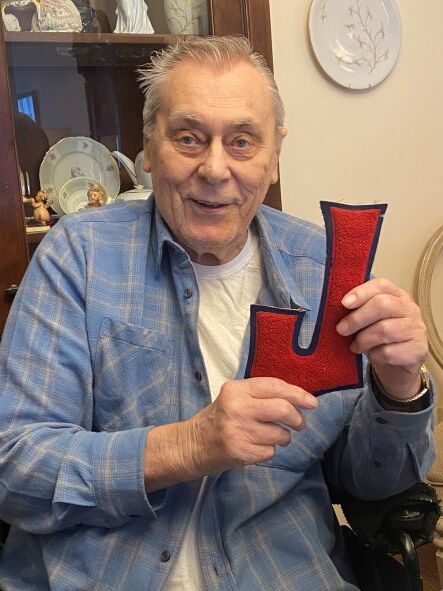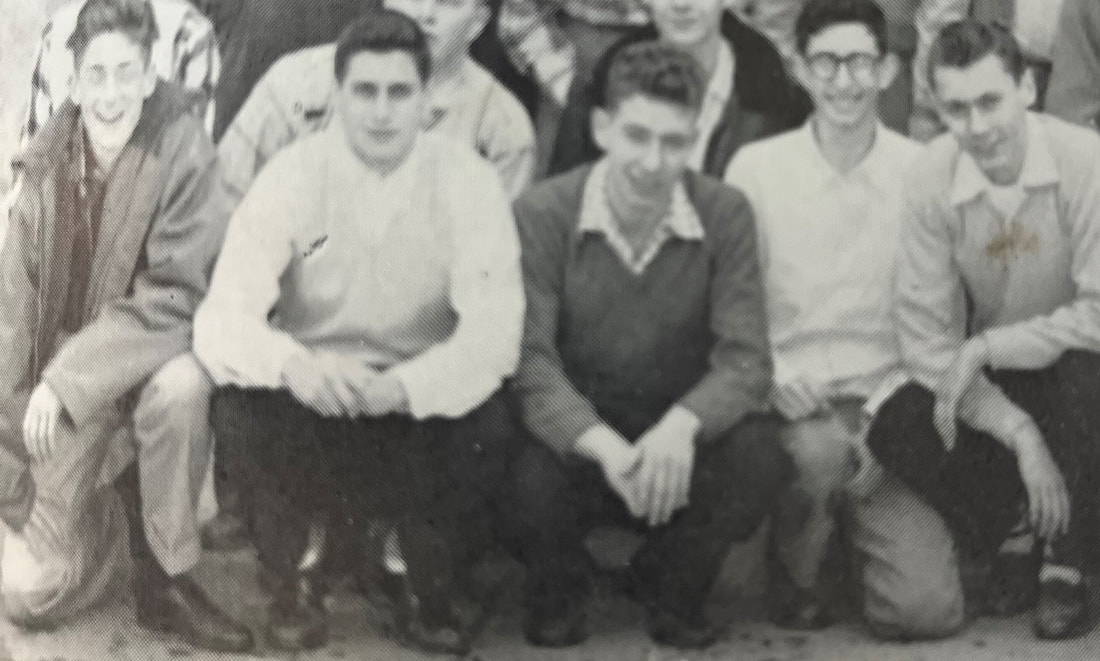 Bob Seel. Photo by Steve Seel Bob Seel. Photo by Steve Seel (We all put stuff in boxes or suitcases and stick them in a closet or an attic or under a bed. And there they sit.) Bob Seel had no shortage of varsity letters – 10 in four different sports at the college formerly known as Philadelphia Textile, now Thomas Jefferson University. This letter popped out of a cardboard box recently – a large “J” from Jamaica High School in Queens, where Bob was the star and captain of the soccer team, as a senior, merely 67 years ago. He called me to say, "I found my letter." I can attest to his skill and leadership. I was a defender of no known skill or experience, when Bob was playing in goal. In his shrill voice, Bob would bark commands at me, as if that would help. By mid-season I was on the bench, which meant I had the privilege of watching Bob Seel -- one of the best players in the city. “We both played two positions,” recalls Dr. Robert Mindelzun, still teaching radiology (via Zoom) at Stanford University, but then a survivor of the terrors of the Holocaust, finding a refuge in Queens. (I wrote about his life not long ago.)
“If Bob was playing up front, I would play goalkeeper, and if Bob was in goal, I would play up front,” Mindelzun said the other day. Mindelzun earned honorable mention in our county, and later played for Queens College before settling in Palo Alto. (By my count, five teammates became doctors.) Dr. Mindelzun recently watched the World Cup, including the tie-breaker device of penalty kicks, that decided the championship for Argentina over France. He doesn’t think he or Captain Seel ever had to deal with a penalty kick because “there was only one ref, and they were not about to call penalties.” If the game was tied, the visitors would get back on the subway and go home. That raised my question: in this modern era, goalies wear gaudy glow-in-the-dark Captain Keeper outfits – yellow, purple, green, red – to differentiate from field players. But in those prehistoric times, keepers wore the same kit as the field players. If we needed a goal, Bob Seel might switch to center forward, and Bob Mindelzun would move back into goal, same outfit. Somehow, the game got played. Seel already had a large varsity “J” from his junior season at Jamaica, which was sewed on a long white sweater. He has no idea what happened to that sweater, but another letter remained in the family home, in a box, until the Seels downsized, a few years ago. “We moved from New Hyde Park to Seaford,” he said. “We had to move because I’m in a wheelchair.” This superb athlete has neuropathy, often connected to nerve damage from one trauma or another. Bob’s wife, Barbara, says he got it from playing too many sports – get this: four years of college soccer (three of them as captain), three years of basketball, two years of baseball and one year of tennis. As a senior at Philadelphia, he was named the outstanding athlete and was given a watch – “which I still have,” he said, adding that it does not work. Most old sports stuff, blessedly, gets tossed out. Pretending to be an athlete, I had my one varsity “J” sewed on a blue satiny jacket with red trim, with on it, and I wore it so often that it was dirty and ragged –– until it got junked in my mid-20s. Bob Seel and I lost contact while he worked as an agent for the Treasury Department and I went into journalism, A couple of decades ago, we met at a reunion and I had a flash of memory of his leadership and his fire and his skill. (Meantime, the geniuses who run New York schools terminated Jamaica High a decade ago, putting three or four smaller schools in that beautiful hilltop building.) While working on my soccer book, “Eight World Cups” for 2014, I talked to Bob about his background in soccer. He told me his dad learned the sport in the Kaiserslautern region in southwest Germany, and then his family moved to the soccer hotbed of Glendale-Ridgewood-Maspeth in Queens. Bob played youth soccer near the hallowed soccer field known as Metropolitan Oval. (I once played defense there against Grover Cleveland High, facing the city skyline and the late afternoon sun, while a curly-haired marauder named Bubbi Herink flitted past me and scored several goals past poor Captain Seel.) Bob and Barbara Seel now live in a complex on Long Island, where he can scoot out to a clubhouse and play cards and schmooze with his pals. I have never heard him complain. Recently, the Seels were sorting through an extra cardboard box, left from their move, and there was the “J” – in pristine condition. What will he do with the letter? “I have no idea,” he said. Their son Steve took a photo of the Captain, flashing that modest, pragmatic smile, holding the “J,” 1/21/2023 11:15:38 am
I hope this wonderful description of Bob Seel's indomitable spirit makes me stop complaining about my arthritis.
GV
1/21/2023 06:04:58 pm
Lee, good point -- although I do notice that a lot of old people (i.e. my age) trade information about one malady or another. That's different from complaining, no? GV
Ed Martin
1/21/2023 01:21:46 pm
Thanks for introducing us to Bob Seel and Jamaica HS, (once again).
GV
1/21/2023 06:15:55 pm
Ed: the only game we played that had followers was at the Met Oval -- because Grover Cleveland HS always had a good team, and also because the Met Oval is in the center of a traditional soccer community with clubhouses and training centers -- like Delphi, Greece. When we went there, we realized why it is called "The Navel of the World." -- a geographic center. The Met Oval didn';t have a blade of grass in those days -- stones, broken glass, bottle caps, etc. But early in this century, the Oval was upgraded to really good green artificial turf --one game after another, wth the city (i.e. Manhattan) looming to the west. I jogged on the new field at the opening and could plant my feet and make a turn...where was that surface when I was a visiting player?
Walter Schwartz
1/21/2023 06:20:55 pm
Bob Seel was certainly one of the greatest all-around athletes Jamaica High in its more than 100-year existence ever produced. Not only that, he was a great leader and inspirer. His coaches and teammates selected him to captain not only the soccer team, but also tennis,bowling and maybe one other. But basketball was the big sport at Jamaica in the mid-fifties and with a New York City championship and the number one player in the City, Alan Seiden, Bob Seel’s exploits took a back seat as did every other great schoolboy athlete. Bob made us proud. (By the way, George, you forgot to identify the pudgy soccer player behind Lew Landsberg in the photo, so Let me say it’s you. Thanks for reminding us of Bob’s accomplishments.)
GV
1/22/2023 09:55:56 am
Chief, you were on the track team...do you remember a basketball game in the gym between the track team and the soccer team,winter of 55-56? I have no idea how it was arranged -- but full court, ref, actually some kids in the stands....Anyway, Bob Seel was The Captain, a very good Press League player in Queens, knew all our varsity players, etc.
Ernest Kirchman
1/21/2023 10:16:30 pm
Hi George, Have been greatly enjoying your articles, which all expand our connection with people and times.
GV
1/22/2023 10:02:11 am
Ernie, great to hear from you. I might have cut practice that day..I was known to do that.,...great memory. You played a lot of defense that year, and had a great view of Bob when he moved up on offense...those long legs, shifting gears. Gretzky-like, indeed! I was in awe that a human body could twist and shift directions like that, I remember Mr. Seel picking up Bob and aother teammate after practice, already dark out....He had learned the sport in Kaiserslautern and Ridgewood....Thanks for the vivid recollection. Best to you both G
Altenir Silva
1/22/2023 05:09:12 am
Dear George, Great story about Bob Seel and your past as a defensive player. Talking about penalties, I remembered a quote by the late João Saldanha (the coach who faced the military dictatorship, was fired, and became the best intellect in Brazilian soccer). Mr. Saldanha said, "The penalty is the most important thing in a soccer game that the team owner should kick."
GV
1/22/2023 10:07:15 am
Dear Altenir: That is a great concept. Make the owners take the field.
Alan D. Levine
1/22/2023 01:12:28 pm
...with five banished attorneys ready to grab the rebound.
GV
1/22/2023 03:04:02 pm
Alan: Five Banished Attorneys sounds dangerous.
Ed
1/22/2023 06:03:44 pm
5 banished attorneys--sounds like Trump white house. Comments are closed.
|
Categories
All
|










